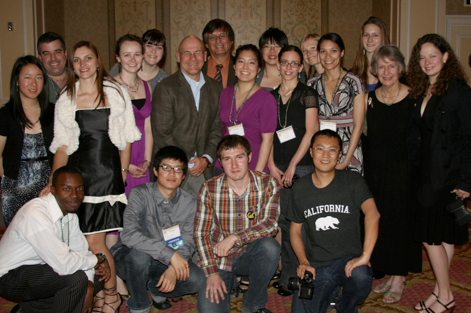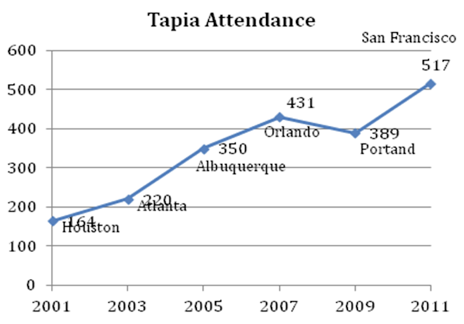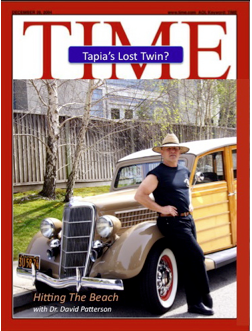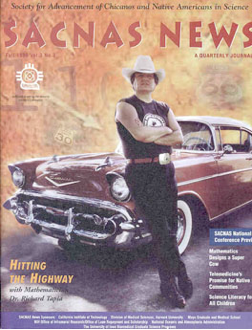Computing Research News
September 2011 Vol. 23/No. 4
Reflections on the 2011 Richard Tapia Celebration of Diversity in Computing Conference
By David Patterson
The goal of the Tapia conferences1 is to bring together undergraduate and graduate students, professionals, and faculty in CS&E from all backgrounds and ethnicities to: 1) Celebrate the diversity that currently exists in CS&E; 2) Create communities of CS&E people with diverse backgrounds, genders, and ethnicities that extend beyond the conference; 3) Receive advice from and make useful contacts with CS&E leaders in academia and industry; and 4) Be inspired by great presentations and conversations with successful people in CS&E who have similar backgrounds, ethnicities, and gender as the attendees. Thus, invited speakers, graduate students, and undergraduates present inspiring research results in talks, workshops, and poster sessions and get career advice in panel sessions and unstructured conversations.

Richard Tapia (center, back) next to the author and part of the UC Berkeley brigade.2
For the ten-year anniversary, the organizers brought me in as a new general chair to take a fresh look at the conference, which was held April 3 to 5, 2011 in San Francisco. Two themes highlight the 2011 Tapia Conference: celebration and diversity. The conference celebrated the technical contributions and career interests of diverse people in diverse computing fields, with an emphasis on inspiring students from diverse communities to continue their education in computing.
Tapia 2011 tried a different format from the past, based in large part on surveys of past attendees. In fact, Tapia 2011 turned out to be an experiment in using modern, Internet-based collaboration tools to collect data and drive the conference. Difficult decisions relied on polls of previous Tapia's attendees using online survey services like Survey Monkey or Google Forms. Unsurprisingly, we found that it was much easier and more likely to be correct when people were asked, versus trying to guess what people would like. Based on the success of Tapia 2011, I recommend that all conference organizers use online surveys of attendees to plan their events.
A Unique Conference: The Most Diverse in Computing
It is striking how diverse Tapia is compared to all other conferences (see photo above). Sticking to form, we use the final survey (completed by 73% of attendees) to supply quantitative evaluation of the conference. First the data:
|
Demographic : Gender? |
||
|
Female |
57% |
|
|
Male |
43% |
|
|
Demographic: Hispanic? |
||
|
Yes |
28% |
|
|
No |
72% |
|
|
Demographic: Race/Ethnicity? |
||
|
African American/Black |
35% |
|
|
Mexican American, Other Latin American |
19% |
|
|
Caucasian/European/White |
26% |
|
|
American Indian or Alaskan Native |
1% |
|
|
Native Hawaiian or Pacific Islander |
0% |
|
|
Asian Indian |
2% |
|
|
Other Asian (Chinese, Korean, Filipino, Vietnamese, Japanese, other) |
9% |
|
|
Middle Eastern |
2% |
|
|
Another race or ethnicity |
4% |
|
Clearly, the makeup of most research conferences is very different from the statistics above. Furthermore, for conferences that focus on a specific
under-represented group, it is usually the case that 90% to 95% of the attendees are from the target group. Ironically, even if the ethnic or gender makeup is very different, they are no more diverse than other CS conferences.
I believe the diversity is one reason Tapia was so popular. If you believe in diversity, there is no better conference!
An Unqualified Success
By all measures Tapia 2011 was a success. Attendance set a record of 517, one-third larger than last time. In fact, we had to close registration the week before the conference because we couldn't fit any more people into the meeting room. We might have shot past 550 without the cutoff.

The 10% drop in Portland was followed by a 33% increase in San Francisco.
A sample of the responses to the survey supports the finding that the conference was effective as well as popular:
- Of those who have attended past Tapia conferences, 70% strongly or slightly prefer Tapia 2011.
- 93% are very likely or somewhat likely to attend Tapia 2013.
- 97% are very satisfied or somewhat satisfied with Tapia 2011.
- 98% are very likely or somewhat likely to recommend Tapia to a colleague or peer.
- According to the students-who were 75% of all attendees, evenly split between undergraduates and grad students-Tapia 2011 met our greater goals:
- 86% agreed or strongly agreed that attending Tapia 2011 increased their dedication to completing their degree.
- 98% agreed or strongly agreed that they are confident that they will complete their degrees.
We also set a fund-raising record with nearly $300,000 in support of the conference, thanks to the efforts of our fund-raising chair Cynthia Lanius of Rice and to the sage advice of Telle Whitney of the Anita Borg Institute. The top 10 supporters were NSF, Google, Intel, Cisco, Microsoft, NetApp, IBM, Symantec, LLNL, and Oracle. The following Gold academic supporters sent 10 or more non-scholarship students:
UC Berkeley (42 attendees total), Rice (26), Georgia Tech (23), UT Austin (20), Texas A&M (17), Cal State University Stanislaus (12), and Virginia Tech (10).
Another sign of success of Tapia 2011 is that 38 professional attendees and 130 student attendees volunteered to help with future Tapia conferences.
Connections: The Tapia 2011 Experiments Worked
The theme of Tapia 2011 was "Connections," in that we are all connected together no matter how we appear or where we currently live, much more than you might expect. I demonstrated such connections in the opening session by talking about the parallels between the lives of Richard Tapia and myself:
- Both grew up in Torrance, California in homes that were three miles apart.
- We are both the first-born sons of large, church-going families.
- We both attended nearby local high schools and community colleges before graduating from UCLA with bachelor's degrees in mathematics.
- We both got married and had children while undergraduates, went to grad school with families, and named our first sons after ourselves.
- Both of us got our PhDs from UCLA before joining academia, where we later chaired our departments.
- Both were elected to the National Academy of Engineering, one year apart.
- Honoring our Southern California roots, we both collect and renovate old cars. The opening presentation showed magazine covers with two of our cars: a 1957 Chevy sedan and a 1935 Ford station wagon. (Note: One cover is fake.)


The connection theme carried through new events for 2011. Eight of the ten top- rated events were tried for the first time at Tapia 2011. These innovations included:
- An afternoon activity break outside conference on Day 2 to help attendees make connections, to let everyone's batteries recharge, and to encourage attendance at the rest of the conference, ably organized by Roxana Infante and Tammy Johnson of UC Berkeley.
- An extended lunch to connect with interesting Bay Area people invited to meet attendees, which Ellen Spertus of Mills College led with aplomb.
- Multiple tracks for the popular Doctoral Consortium so that more PhD students could receive advice and make connections with an expert panel and other PhD students, smoothly chaired by Anthony Joseph of UC Berkeley and Juan Vargas of Microsoft.
- A student opportunity poster session where students could get to know companies and individual research projects that had opportunities for students, which NSF's Jose Munoz successfully organized.
- An optional visit on the day after the conference to nearby institutions including Google, LBNL, LLNL, and UC Berkeley, to make connections outside the conference.
Including a larger number of invited speakers for Tapia 2011 was also popular:
Blaise Agüera y Arcas (Microsoft), Deborah Estrin (UCLA), Alan Eustace (Google), Illya Hicks (Rice), Ayanna Howard (Georgia Tech), John Kubiatowicz (UC Berkeley), Patty Lopez (Intel), and Irving Wladawsky-Berger (IBM retired).
See You in 2013 (and Shortly Thereafter)
A final indication of the success of Tapia 2011 is that CDC plans to make Tapia an annual event starting in 2013. Based on survey feedback, the next Tapia will be moved to late February so that students can apply for internships with companies at Tapia. This feedback also suggested that a Friday-Sunday conference would be a lot easier for students to attend, so the next conference will likely be held some weekend in February 2013. Watch this space for the final dates and location.
Tapia 2011 wouldn't have happened or been as successful without the hard work of a lot of volunteers and the financial support of a lot of organizations. I'd like to thank everyone, but especially those mentioned earlier as well as:
- Juan Vargas (Microsoft), who was my vice chair (and is chair for Tapia 2013).
- Cynthia Lanius (Rice), who chaired the record-breaking fund-raising effort.
- Hal Marz (Google) and Ryan Hundley (Google), who handled the substantial challenges of local arrangements.
- Jamika Burge (Penn State) and Tiki Suarez-Brown (Florida A&M), who served as Scholarships Chairs for hundreds of applicants.
- Tony Baylis (LLNL), who ran registration for a surprisingly large conference.
- Jon Bashor (LBNL), who ran publicity and made us all sound eloquent.
- Tony Drummond (LBNL), who led the student research poster session.
- Phoebe Lenear (Illinois) and Josef Sifuentes (NYU), who organized the popular banquet.
- Manuel Perez Quiñones (Virginia Tech), who represented CDC.
- Richard Tapia (Rice) and Valerie Taylor (Texas A&M) for inviting me to chair the conference; it turned out to be a much bigger and more demanding venture than any of us expected!
David Patterson is Director of the Parallel Computing Laboratory and the Pardee Professor of Computer Science at UC Berkeley. He is a former chair and member of the Computing Research Association's Board of Directors.
Notes:
1 - Tapia Conferences are organized by the Coalition to Diversify Computing (CDC) and sponsored by ACM in cooperation with CRA and the IEEE Computer Society.
2 - UC Berkeley sent 42 people to the conference, the most of any institution. In fact, Berkeley and Stanford combined sent 42 people.
1828 L STREET, NW SUITE 800, WASHINGTON, DC 20036 | P: 202-234-2111 | F: 202-667-1066




